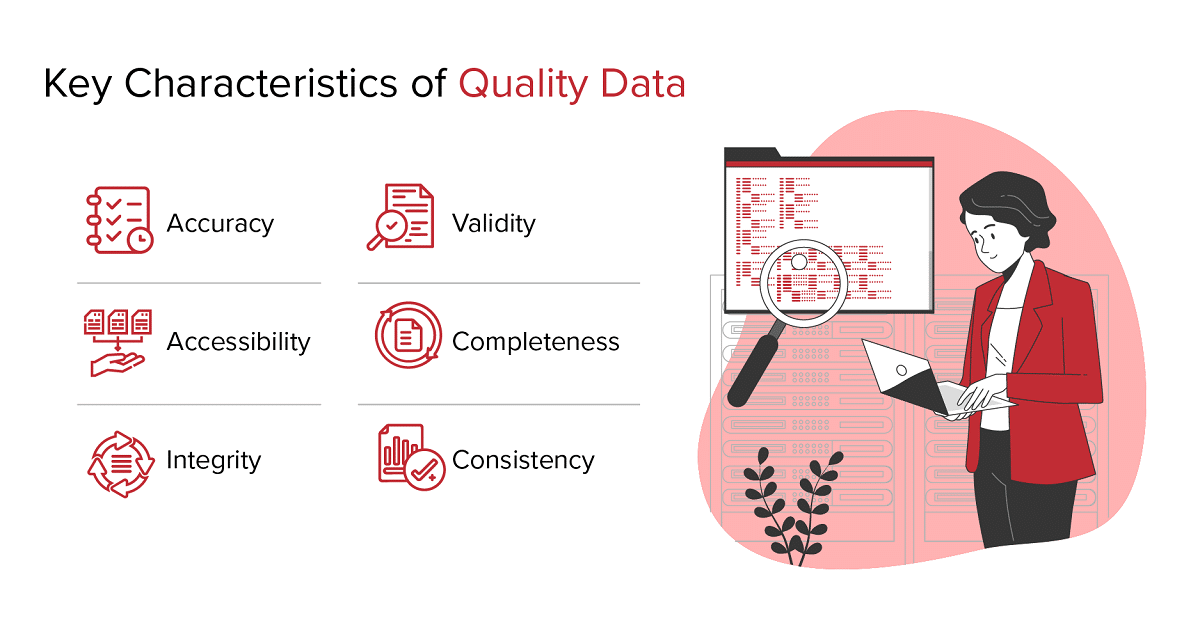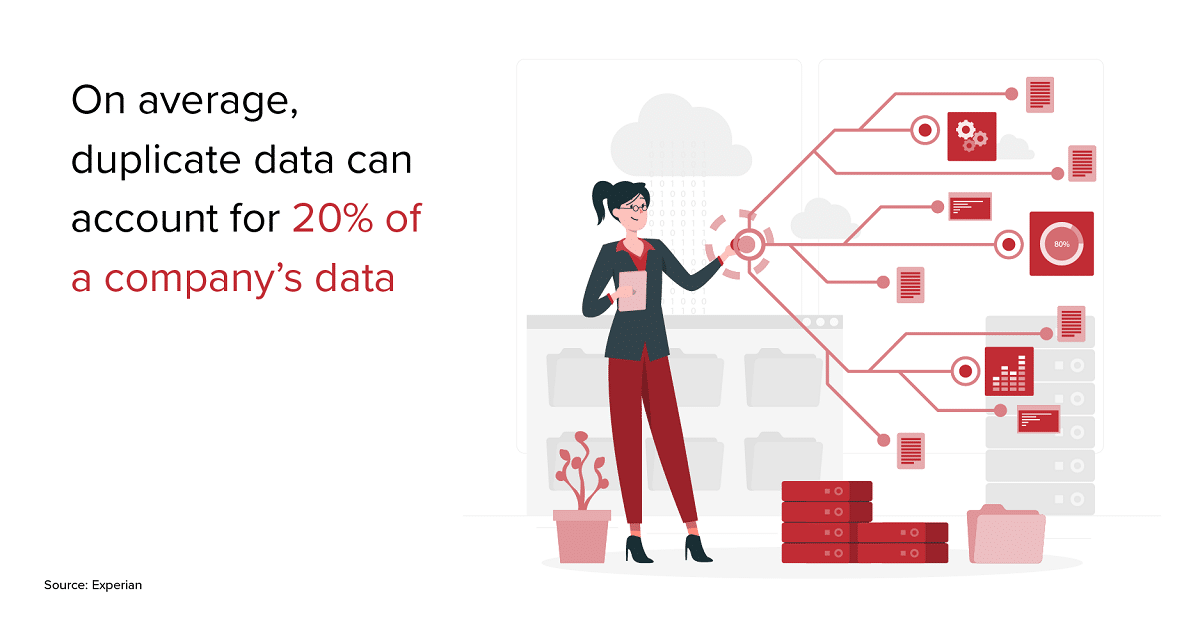Any marketer’s worst nightmare- sending a marketing email to the wrong address, or worse, receiving a bounce-back because the email doesn’t even exist. This is the reality of using dirty data, which plagues many marketing campaigns. Data cleansing is the solution. It helps give your data a thorough scrub-down, removing duplicates, fixing errors, and ensuring everything is formatted consistently. It is the crucial first step on the path to unleashing the true power of data, enabling organizations to run effective campaigns, identify valuable insights, and drive business success. In this blog, we dive into the data cleansing process and uncover the secrets it holds for unlocking the full potential of your data.
 Select an element to maximize. Press ESC to cancel.
Select an element to maximize. Press ESC to cancel.What is Data Cleansing?
Data cleansing, also known as data scrubbing or data cleaning, is the process of detecting and removing or correcting errors, inconsistencies, inaccuracies, and duplicates in a dataset. It involves identifying and rectifying any discrepancies or anomalies to ensure that the data is accurate, complete, and reliable.
The goal of data cleansing is to enhance B2B data quality by eliminating or minimizing errors that could impact deliverability, targeting, prospecting and campaign ROI. It plays a crucial role in ensuring campaign effectiveness, prospect engagement and conversion.
Importance of Data Cleansing Process
It is no secret that right prospecting and targeting is crucial for success in today’s competitive B2B sector. But what happens when your decisions are based on data that is unreliable, inaccurate or redundant? This is something that is not talked about enough. Data cleansing should be given equal priority to data collection to obtain the most accurate insights.
Data cleansing techniques focus on identifying and rectifying errors, inconsistencies, and inaccuracies within datasets. It is crucial because it guarantees you have the best data that’s accurate and reliable. This will reduce errors, boost productivity, and improve campaign effectiveness and ROI.
A variety of errors and problems in B2B data sets, such as inaccurate, invalid, incompatible, and corrupt data, are addressed by data cleansing. Some of these issues are brought on by human error when data is entered, while others occur due to inconsistent data structures, formats, and terminologies in various systems across an organization.
Here are a few issues that are frequently resolved as part of the data cleansing process:
• Typos and incomplete or incorrect data
Different structural errors in data sets are fixed by data cleansing. This includes typographical errors, incorrect numerical inputs, syntax errors, and missing values, such as empty or null fields that should have been filled with data.
• Inconsistent data
Different systems frequently use different formats for names, addresses, and other attributes. For instance, a customer’s middle initial might be present in one data set but not in another. Data cleansing makes sure that the data is consistent, enabling accurate analysis.
• Duplicate data
Data cleansing uses deduplication techniques to identify duplicate records in data sets and remove or merge them. For instance, when data from two different systems are combined, duplicate data entries can be resolved to produce a single record.
• Irrelevant data
Some data, such as outliers or old entries, may be irrelevant to analytics applications and can skew their results. Data cleansing eliminates redundant data from data sets, which speeds up data preparation and reduces the amount of data processing and storage needed.
Benefits of Data Cleansing Process: Unlock the Power of Clean Data
Data cleansing plays a vital role in ensuring high-quality data and deriving meaningful insights from it. Here are a few of the many benefits you can derive from it:
1. Staying Organized
Businesses today gather a lot of B2B data from clients, product users, and other sources including B2B data providers. These details range from addresses and phone numbers to bank information and more. Regular data cleansing helps maintain order. It can then be more proficiently and securely stored.
2. Error Prevention
Bad data doesn’t just affect campaign analytics, daily operations are also impacted. For instance, marketing departments typically have a large database of customers. Data cleansing ensures they have access to useful, accurate information. On the other hand, cost of bad data is chaos, like using the wrong name in personalized email blasts.
3. Increased Productivity
By regularly updating and cleaning data, erroneous data is quickly and effectively eliminated. Teams will no longer need to search through outdated databases or documents to find what they need.
4. Reduced Costs
By eliminating duplicate records, organizations can avoid unnecessary expenses related to maintaining and managing redundant data. Moreover, clean and accurate data reduces the likelihood of errors and mistakes, which can lead to costly repercussions or rework. Checking the data frequently makes it possible to spot blips earlier. This gives you a chance to fix them before a more time-consuming (and expensive) fix is necessary.
5. Better Mapping
Businesses are increasingly looking to upgrade their internal data infrastructures. To do this, they frequently work with data analysts to develop new applications and perform data modeling. A sound B2B data hygiene strategy is a wise move because clean data from the start makes it much simpler to collate and map.
6. Enhanced Customer Relationships
Clean data enables personalized communication, improving customer satisfaction and loyalty. With accurate customer information, you can tailor messages to individual preferences, fostering stronger connections and increasing engagement. This targeted approach leads to happier customers who feel valued by your brand, ultimately driving loyalty and long-term growth.
Embracing The Future of Data Cleansing
As technology evolves and marketing needs change, the world of data cleansing keeps shifting. So, what’s next for B2B data cleansing in marketing? Let’s take a peek ahead and explore some trends shaping this crucial process.
1. Embracing AI and Machine Learning
Gone are the days of sci-fi; AI and machine learning are here, transforming how we handle data. In B2B data cleansing, these technologies automate tedious tasks like spotting duplicates, fixing formatting errors, and standardizing data. This not only saves time and resources for marketers but also ensures higher accuracy.
Bad data doesn’t just affect campaign analytics, daily operations are also impacted. For instance, marketing departments typically have a large database of customers. Data cleansing ensures they have access to useful, accurate information. On the other hand, cost of bad data is chaos, like using the wrong name in personalized email blasts.
2. Exploring the Potential of Natural Language Processing (NLP)
Have you ever wondered how machines understand human language? Natural Language Processing (NLP) is the key! In data cleansing, NLP works its magic on unstructured data such as emails, social media posts, and customer reviews. It sifts through this data, extracting valuable insights and enriching existing data profiles. This comprehensive understanding empowers marketers to create personalized campaigns that truly resonate with their audience.
For example, NLP can analyze customer service interactions to identify pain points or preferences, enabling marketers to tailor their messages accordingly. It’s an extra set of eyes and ears to help optimize marketing strategies.
3. Collaborative Data Cleaning
Get ready to see more collaborative solutions, where organizations leverage data cleansing outsourcing to scrub data spotless. This means everyone’s on the same page, with consistent information that fuels marketing efforts without any hiccups. Plus, these collaborative platforms will keep a close eye on data governance, making sure we stick to privacy rules and ethical data practices.
4. Prioritizing Data Privacy
With regulations like GDPR and CCPA on the rise, data security and user consent have taken center stage. B2B data cleansing tools must evolve to meet these requirements. Expect to see features like anonymization and user consent management becoming key components of data cleansing solutions. Moreover, marketers will need to focus on being transparent in their data collection practices to earn customer trust and demonstrate responsible data usage.
 Select an element to maximize. Press ESC to cancel.
Select an element to maximize. Press ESC to cancel.5. The Integration of Data Lakes and Data Warehouses
Data lakes and warehouses play crucial roles in managing and analyzing large volumes of data. Looking ahead, we can expect a tighter connection between data cleansing and these storage solutions. Data cleansing tools will seamlessly mesh with data lakes and warehouses, guaranteeing that clean data flows smoothly into the analysis phase. This will result in deeper insights and more powerful marketing strategies that rely on data every step of the way.
6. The Shift Towards Predictive Maintenance
The future is all about being proactive with predictive maintenance. Instead of waiting for data hiccups to happen, picture foreseeing and addressing them before they even occur. With the help of AI and machine learning, data cleansing tools will analyze patterns and anticipate future issues. This proactive stance ensures B2B marketers stay ahead of the game, keeping their data in top shape and their marketing efforts running smoothly.
Overall, the future of data cleansing will involve a combination of advanced technologies, automation, and data governance practices to ensure high-quality, reliable, and secure data for decision-making and analysis.
Unleashing the Power of Your B2B Data: Cleansing and Enrichment
Data is a powerful tool for marketers, but raw data often needs work before it delivers its full potential. Here’s a breakdown of data cleansing and enrichment, the dynamic duo that helps you get the most out of your marketing efforts.
Building a Strong Foundation with Data Cleansing
Data cleansing focuses on the accuracy and structure of your data. It involves tasks like:
- Eliminating duplicates: Duplicate entries skew your data and waste resources. Cleansing removes them, ensuring a clean and efficient database.
- Correcting errors: Typos, formatting inconsistencies, and inaccurate information can distort your analysis. Cleansing identifies and fixes these errors.
- Standardizing data: Inconsistent formatting makes data difficult to analyze. Cleansing ensures all records have a consistent format for easy comparison and utilization.
Adding Layers of Insight with Data Enrichment
Once your data is clean, enrichment adds valuable details to each ecord. This can include:
- Firmographics: This provides details about your customers’ companies, such as size, industry, and location. It gives you a clearer picture of who your customers are.
- Technographics: This reveals the technology your customers use. Understanding their tech preferences helps tailor your marketing messages accordingly.
- Demographics: This includes details like age, gender, income, and location. It allows you to create a detailed customer profile and understand your audience on a deeper level.
By enriching your data, you gain a deeper understanding of your audience. It gives a detailed customer profile for each record, allowing for more targeted and effective marketing strategies.
Why This Combination is a Game-Changer for B2B Marketers
- Precision Targeting: Clean data allows for accurate targeting, while enrichment enables segmentation based on specific customer characteristics. You can reach the right people with the right message.
- Personalized Experiences: With enriched data, you can personalize content and offers, fostering stronger connections with your audience.
- Enhanced Campaign Performance: Clean and enriched data fuels hyper-targeted campaigns with pinpoint accuracy, leading to better results.
- Customer Insights: Enriched data yields valuable customer insights that inform strategic decisions and help predict future needs.
Data cleansing and enrichment are ongoing processes. Regular maintenance, data governance policies, automation tools, and constant monitoring are crucial for keeping your data accurate and effective over time. By investing in data cleansing and enrichment, you unlock the true potential of your marketing data. This translates to impactful campaigns, deeper customer understanding, and ultimately, achieving your business goals.
Conclusion
Data cleansing is of paramount importance for any B2B organization that seeks to thrive in today’s data-driven landscape. By removing inaccuracies, inconsistencies, and redundancies from their datasets, businesses can unlock a multitude of benefits. Improved data accuracy empowers informed decision-making, enhances operational efficiency, and ultimately leads to better business outcomes. Additionally, data cleansing enables organizations to comply with regulatory standards, safeguard data security and privacy, and optimize resource allocation.
Even though there will inevitably be instances where bad data gets mixed up with your valuable data, you can make sure that your good data stays exactly as it should be by working with a reputable B2B data services provider. Write to us at marketing@datamaticsbpm.com to harness the full potential of your data, gain a competitive edge, and pave the way for success in a rapidly evolving digital world.
 Select an element to maximize. Press ESC to cancel.
Select an element to maximize. Press ESC to cancel.Frequently Asked Questions
Correcting errors or inconsistencies in data or reorganising it to make it more usable are both examples of data cleansing. Standardizing dates and addresses, checking that field values—such as “Closed won” and “Closed Won”—match, extracting area codes from phone numbers, and flattening nested data structures—all fall under this category.
Data cleansing, also referred to as data cleaning or scrubbing, is the process of identifying and eliminating errors, irrelevant and duplicate data from a raw dataset.
Data pre-processing, also known as data cleansing, is the first step in data extraction. The goal of data cleansing is to simplify the dataset so that it is easier to work with. One observation per row and one variable per column are two traits of a clean/tidy dataset.

James Libera




